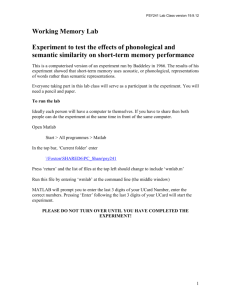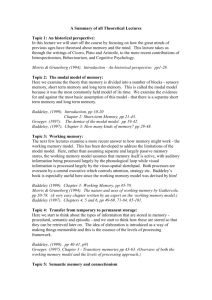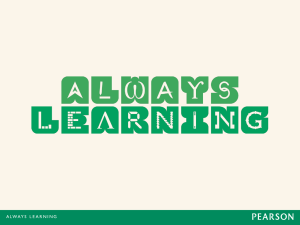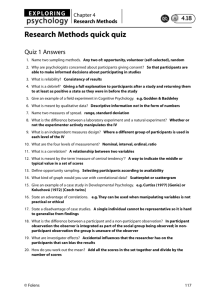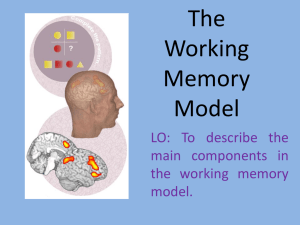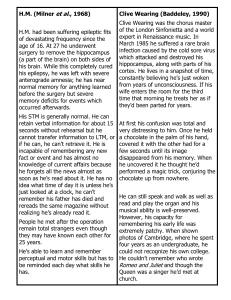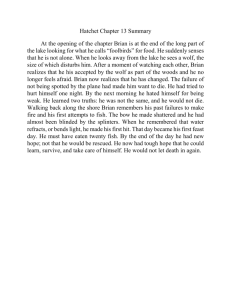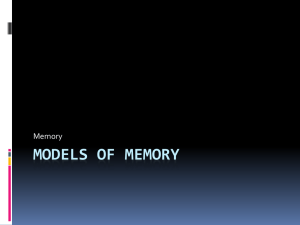Title: Do adaptive computerised training programs designed to
advertisement
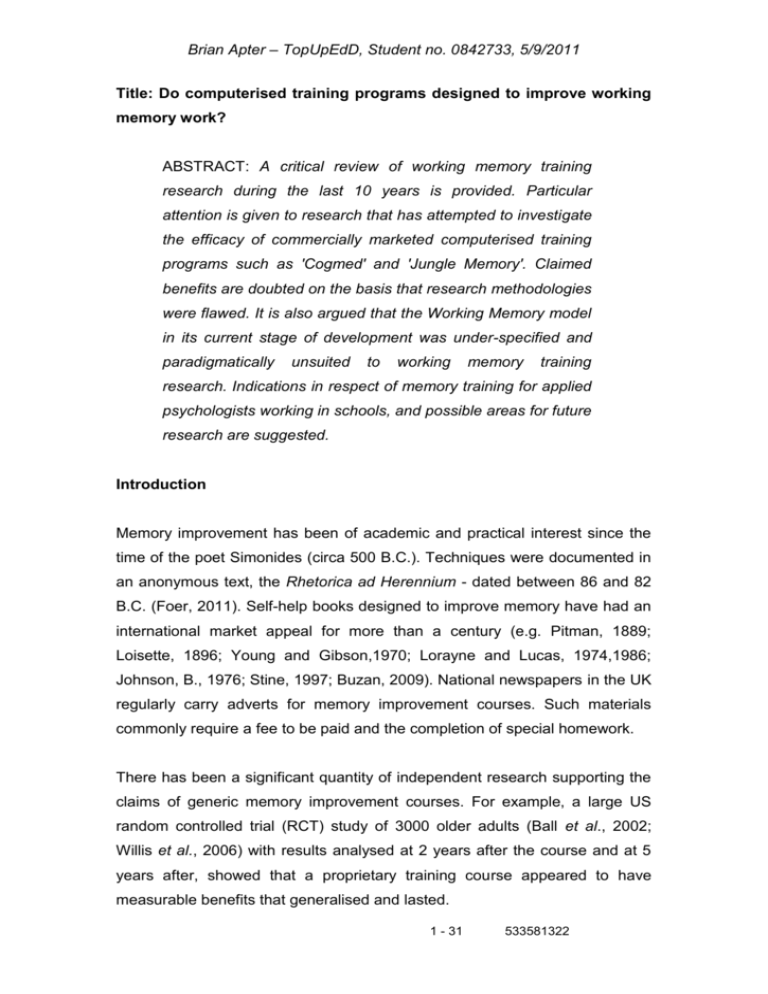
Brian Apter – TopUpEdD, Student no. 0842733, 5/9/2011 Title: Do computerised training programs designed to improve working memory work? ABSTRACT: A critical review of working memory training research during the last 10 years is provided. Particular attention is given to research that has attempted to investigate the efficacy of commercially marketed computerised training programs such as 'Cogmed' and 'Jungle Memory'. Claimed benefits are doubted on the basis that research methodologies were flawed. It is also argued that the Working Memory model in its current stage of development was under-specified and paradigmatically unsuited to working memory training research. Indications in respect of memory training for applied psychologists working in schools, and possible areas for future research are suggested. Introduction Memory improvement has been of academic and practical interest since the time of the poet Simonides (circa 500 B.C.). Techniques were documented in an anonymous text, the Rhetorica ad Herennium - dated between 86 and 82 B.C. (Foer, 2011). Self-help books designed to improve memory have had an international market appeal for more than a century (e.g. Pitman, 1889; Loisette, 1896; Young and Gibson,1970; Lorayne and Lucas, 1974,1986; Johnson, B., 1976; Stine, 1997; Buzan, 2009). National newspapers in the UK regularly carry adverts for memory improvement courses. Such materials commonly require a fee to be paid and the completion of special homework. There has been a significant quantity of independent research supporting the claims of generic memory improvement courses. For example, a large US random controlled trial (RCT) study of 3000 older adults (Ball et al., 2002; Willis et al., 2006) with results analysed at 2 years after the course and at 5 years after, showed that a proprietary training course appeared to have measurable benefits that generalised and lasted. 1 - 31 533581322 Brian Apter – TopUpEdD, Student no. 0842733, 5/9/2011 Foer (2011) provided an account of how memory skills can be improved to the extent that the author was able to enter and win a national memory contest in the USA. Foer described techniques to store and recall information efficiently including the use of visualisation keys - so called 'memory palaces', and elaborative encoding using mnemonics. Foer proposes that memory improvement was not about increasing capacity but about using mental resources more skilfully. There have also been some critical findings. For example, Sullivan and Madden (2008) failed to find any benefit in using Memory Power materials with young adults; and Owen and colleagues (Owen et al., 2010) did not detect any transfer effects from brain-training computer games used by 11000 subjects. Owen's BBC funded and mediated research was criticised by the Swedish neuroscientist, Torkel Klingberg. Klingberg alleged that there was a lack of rigour with Owen's research (Callaway, 2010). What emerged in reviewing the generic memory training literature was that with the claim that memory had or had not been improved, the nature of an improvement was often not specified: for example, new memorisation or recall strategies, speed of storage, speed of recall, accuracy of storage, accuracy of recall, a memory capacity increase, or a combination of any or all of these. Working Memory Training A subset of generic memory training has been the comparatively recent innovation of working memory training (Gathercole, 2008). Recently there appeared to be increasing interest from educationalists in the potential of working memory training (Bakalar, 2008; Buckley, 2008). The working memory paradigm (Baddeley and Hitch, 1974; Baddeley, 2000), its limitations, and whether it can be used to meaningfully scrutinise claimed working memory training outcomes is discussed later. Despite possible limitations, the market for 'adaptive' computerised working memory training programs appears ripe. Neuroscientific researchers have made optimistic claims for the 2 - 31 533581322 Brian Apter – TopUpEdD, Student no. 0842733, 5/9/2011 efficacy of programs such as Jungle Memory (Alloway, 2010) and the Cogmed Working Memory Training Program (Klingberg, 2009) in respect of future educational attainment and the amelioration of special educational needs. For example, Buckley (2008) claimed particular benefits for children and young people with Down Syndrome and Klingberg et al. (2005) claimed benefits for children with Attention Deficit Hyperactive Disorder (ADHD). The term: 'adaptive', as applied to computerised working memory programs such as Cogmed and Jungle Memory, describes computer programs that utilise training tasks that are automatically adjusted in difficulty according to a continual reassessment of a subject's so-called working memory capacity. It is claimed that a subject's working memory capacity has thus been optimally exercised and stretched against successive baselines and that the subject’s working memory capacity has been increased. These newer programs contrast with older generic memory training materials that endeavour to provide students with new memory skills and strategies for storage and recall, but do not claim to increase working memory capacity. If Klingberg and Alloway were correct about the utility of their respective adaptive working memory training computer-programs, the international educational market for Jungle Memory and for the Cogmed program would be potentially highly profitable. Recent research review - working memory training Gathercole (2008) was compelling in a keynote review of research in emphasising the importance of working memory functioning to the educational outcomes of children and young people but did not advocate working memory training. Gathercole advised that teachers needed to take account of deficits in pupils' working memory by making adjustments to the classroom environment and to the way that the curriculum was delivered. 3 - 31 533581322 Brian Apter – TopUpEdD, Student no. 0842733, 5/9/2011 Gathercole suggested that the training of working memory skills using computer programs showed promise, but that research had not been conclusive: 'As yet, the precise source of the improvement in working memory performance in training is not fully understood, and may arise from enhancement in basic memory capacity, strategies or both.' (Gathercole, 2008, p.385). In a book published in the same year Gathercole and Alloway (2008) wrote: 'We have no direct evidence that general working memory capacity can be improved by training in low [sic] memory children. Some research has attempted to enhance working memory by training children in the use of highly specific strategies, but the gains have been small despite intensive training, and have not generalised to other memory situations.' (p. 106) Indeed, a review of the small quantity of available research from 20 years ago to the present day investigating the efficacy of working memory training using either random control trials or subtractive experimental designs has been equivocal about its benefits. Flynn and Storandt (1990) concluded that there were no significant benefits to be gained from working memory training with older adults. Olson et al.,(2005) described research where the functioning (speed and accuracy) but not capacity of visuo-spatial memory was improved after a repeating visual memory training task had been completed. Jaeggi et al. (2008) proposed that fluid intelligence was increased after working memory training had been completed. The researchers noted that working memory and fluid intelligence shared a 'common variance' (p.1). Moody (2009) criticised the methodology of this research noting that the 4 - 31 533581322 Brian Apter – TopUpEdD, Student no. 0842733, 5/9/2011 training tasks employed were similar to the tasks used by the measurement tool: the BOMAT (Bochum's Standard Matrices, Hossiep and Hasella, 2010). There were a number of other problems with the research of Jaeggi et al. (2008) that exemplified the potential for obscuring experimental effects that pervades much of the research concerned with working memory training. Jaeggi et al. elected to use a 'no training' control group model. This invited the criticism that the experimental group had much more experimenter attention than the control group, and the possibility that there had been a Hawthorne effect. It also meant that the confounding effect that Moody (2009) identified, was more pronounced than if an alternative placebo-type training intervention had been used as a comparison condition. There were also problems with the specification of the pre- and post-intervention measures of working memory: digit span and reading span. Chase and Ericsson (1982); and Pickering and Gathercole (2001) had previously noted limitations in the specificity of the digit span task as a measure of working memory, and Shipstead et al. (2010) noted difficulties with the use of reading span. The latter also noted that the Jaeggi et al. (2008) effect size over time was small. In Gathercole’s (2008) key note article Gathercole referred to research by Klingberg et al. (2002; 2005). Klingberg and colleagues proposed that the Cogmed computer program had improved the functioning of working memory of a small sample (n=42) of children with ADHD. The improvement claimed appeared to be in respect of the functioning of the visuo-spatial component of the working memory of subjects using a span-board (or Corsi blocks) test. Klingberg reported that an increase in working memory capacity had been achieved. Klingberg conceived and designed the Cogmed program in 1999, (CogMed, 2009). Klingberg was also a founding member of Cogmed Systems, the international program marketing company, and is an executive member of its board. 5 - 31 533581322 Brian Apter – TopUpEdD, Student no. 0842733, 5/9/2011 Klingberg and colleagues at the Karolinska Institute, Stockholm, supported their claim to have increased the capacity of working memory with a study (Olesen et al., 2004) employing functional magnetic resonance imaging (fMRI). In two small scale experiments (n=3 male adults; and n=8: 2 male and 6 female adults), researchers scanned subjects whilst performing cognitive tasks, before, during and after 5 weeks of working memory training. Resultant scans were used to support the researchers' claim that the Cogmed program had induced a 'cortical plasticity' (p. 78) that underlay increased task-related pre-frontal and parietal activity. Jonides (2004), in the same issue of the journal, suggested caution noting that the quantity of data might be insufficient to adequately support Klingberg's claims. A book by Klingberg, 'The Overflowing Brain' (Klingberg, 2009) and a discursive paper (Klingberg, 2010) attempted to provide theoretical support for the possibility of working memory capacity increase by suggesting that working memory tasks recruited neurons in the frontal lobe that then became specialised for working memory tasks: 'As regards working memory, one theory posits that the sensory information from the rear parts of the brain is conveyed to the specialised neurons of the frontal lobe in a way not dissimilar to grandmother cell theory.' (Klingberg, (2009, p.51) Grandmother Cell Theory is the theoretical proposition that there are specialised neurons dedicated exclusively to particular tasks, for example, the recognition of a person's grandmother (Baddeley et al., 2009) or perhaps temporary working memory storage. Klingberg continues: ‘There are also studies, however, showing that information cannot always be gleaned simply from the activity of the nerve cells in the frontal lobes. Certain cells exhibit working memory activity regardless of the type of stimulus being memorized.' (p.51) 6 - 31 533581322 Brian Apter – TopUpEdD, Student no. 0842733, 5/9/2011 Subsequently, Klingberg and colleagues (McNab et al., 2009) proposed a stronger hypothesis about where in the neuron mechanism the plasticity, and thus potential for increased working memory capacity was to be found. From the results of an experiment employing both positron emission tomography (PET) and fMRI scans of 13 males aged between 20 and 28, the researchers claimed that: 'We show that the training of working memory [using the Cogmed program] which improves working memory capacity, is associated with the changes in the cortical density of cortical dopamine D1 receptors. Fourteen hours of training over 5 weeks was associated with changes in both prefrontal and parietal D1 binding potential. This plasticity of the dopamine D1 receptor system demonstrates a reciprocal interplay between mental activity and brain biochemistry in vivo.' (p. 800) This sounds impressive but reading the report indicates: 1. Baseline and post tests used to measure subjects' working memory capacity were under-specified. 2. Control and experimental conditions in respect of the type of training tasks that were used were under-specified. 3. It is not clear how similar test tasks and training tasks were. 4. There was no alternative hypothesis; for example, the possibility that it was the attentional workload that created the effect rather than the plasticity of working memory. 5. There was no longer term follow-up to ascertain whether the changes in cortical dopamine D1 receptor binding lasted significantly beyond the period of training. 6. There might have been a selection effect in respect of such a small homogeneous group of adult male volunteers. 7. The previous learning and training experiences of subjects did not appear to have been controlled for. 8. The change in cortical dopamine D1 receptor binding and the claim that this can be associated with an increase in working memory capacity is speculative. 7 - 31 533581322 Brian Apter – TopUpEdD, Student no. 0842733, 5/9/2011 Baddeley (2009) identified general problems with neuro-imaging studies, citing Duncan and Owen (2000), and noting: '... a lack of consistency across studies at anything other than the broadest level.' (p. 66) Gathercole and colleagues, (Holmes, et al., 2009a; 2009b) also employed the Cogmed program in research. The authors cited Klingberg's research (2002; 2005) but stopped short of similarly claiming to have achieved an increase in working memory capacity, attempting instead to demonstrate generalisation by presenting evidence for gains in subjects’ subsequent educational outcomes, e.g. improved standardised reading and spelling scores. An exclusive association where no other variables are playing a part is improbable however. Alloway (2010) claimed that training using Jungle Memory (Memosyne, 2007), an online licensed computer program, marketed by Memosyne Ltd., improved general learning outcomes, particularly for children with dyslexia, language impairments, motor dyspraxia, and ADHD. Alloway is listed as the company secretary for Memosyne Ltd. by Companies House but does not disclose this in the article. No research findings to support the benefits of Jungle Memory in respect of any of these conditions were cited. Whilst Klingberg et al.'s research (2002; 2005) was cited as supporting Alloway’s claims in respect of using Jungle Memory with children with ADHD, Klingberg (Cogmed, 2009) has been adamant that only the Cogmed program can achieve the capacity increasing effect he and colleagues have reported. Chein and Morrison (2010) conducted a small scale study of 25 female undergraduates. They endeavoured to show the effect of an adaptive working memory training program on capacity, attentional processes, and reading comprehension. The outcomes were significantly improved but only re-tested at the end of the 4 week course and longer term: generalisation could not be claimed. 8 - 31 533581322 Brian Apter – TopUpEdD, Student no. 0842733, 5/9/2011 In a subsequent review, Morrison and Chein (2011) reviewed evidence for positive working memory training outcomes. They concluded that effort and expectancy effects were generally not accounted for in research - including their own. Another experimental error they found in much of the research they reviewed but which their own study was intended to avoid was the use of test tasks that were similar in both assessment and training phases of experiments. Shipstead, Redick and Engle (2010) also compiled a review of research. They concluded that Chein and Morrison's 2010 study was singularly more impressive methodologically than most but too small in scale for the results to be significant. The focus of their review was particularly related to the extent to which research has demonstrated the generalisation of working memory training outcomes. With some of the research they review, generalisation was not an intention, e.g. Klingberg's PET scan research (Oleson et al., 2004). Nonetheless, summarising their critique, Engle and colleagues report multiple methodological problems with the research they reviewed including: 1. Inadequate specification of 'near' and 'far' transfer effects, e.g. Klingberg et al., (2002); Alloway, (2010). 2. Undetectable 'far' transfer effect, e.g. Holmes et al., (2009a; 2009b). 3. Small sample size and / or inadequately specified control group, e.g. Alloway and Alloway, (2009); Holmes et al., (2009b); Klingberg et al., (2002). 4. Normal maturation and learning not accounted for in post-training measures, e.g. Klingberg et al., (2005); Holmes et al., (2009a). 5. Previous experience of the subjects of the type of assessment materials used in research inadequately controlled for, e.g. Holmes et al., (2009a; 2009b). 6. Inadequate control of other cognitive processes affected by test conditions particularly the way in which fatigue and stress during test procedures affect attentional processes, e.g. Klingberg et al., (2002; 2005); Oleson et al., (2004) 7. Selection effects, e.g. in respect of the method of ADHD diagnosis being unspecified e.g. Klingberg et al., (2002; 2005); Holmes et al., (2009b). 9 - 31 533581322 Brian Apter – TopUpEdD, Student no. 0842733, 5/9/2011 8. Expectancy effect by virtue of subjects association with researchers, possibly incorporating a Hawthorne effect, e.g. Klingberg, et al., (2002; 2005); (Oleson et al., 2009). Shipstead, et al. (2010) concluded that the case for adaptive working memory training successfully generalising had not been proven. Adopting a wider view of the working memory training research but incorporating Shipstead et al.'s (2010) review, it appears that in order to establish whether working memory training works, researchers have occupied themselves with proving one of the following: 1. Outcomes have been positive over a long term as proven by test and retest using a working memory test battery. 2. Outcomes have generalised to long-term increases in proprietary measures of intelligence. 3. Outcomes have been associated with positive long-term changes in the physiology of the brain. 4. Outcomes have been positively associated with improved educational learning outcomes over an extended period. 5. A combination of any or all of the above. Any of these outcomes – had they been plausibly demonstrated, could have been construed as being indicative of a permanent increase in working memory capacity. The research evidence remains equivocal however and on balance it appears that any claim of having achieved working memory capacity increase has been unfounded. Discussion The discussion that follows firstly examines the Baddeley and Hitch (1974) working memory model and the augmented model that includes an episodic buffer (Baddeley, 2000) and considers whether there might be inherent limitations with the model that preclude certainty in respect of working 10 - 31 533581322 Brian Apter – TopUpEdD, Student no. 0842733, 5/9/2011 memory training research findings; and whether there are competing models that might offer further illumination on the issue of training efficacy. The second part of the discussion considers the attribute of capacity as it was used in the original conceptualisation of the working memory model (Baddeley and Hitch, 1974) and how it has been subsequently understood by researchers investigating working memory training. The third part of the discussion concerns the limitations that might apply to research methods as they have been employed in investigating working memory training research. The term 'working memory' was first employed in 1960 by Miller, Gallanter and Pribam as a theoretical conjecture. Working memory was refined as a concept by Atkinson and Shiffrin (1968) but as a subsidiary function of shortterm memory. The subsequent three component working memory model was a theoretical device intended to steer experimental memory research (Baddeley, 2001). Baddeley and Hitch (1974) conceived of working memory as comprising a visuo-spatial scratchpad, a phonological loop and an attentional controller the central executive. Baddeley described the utility of the working memory model thus: '... a theoretical framework whose function was to give an economical and coherent account of a relatively wide range of data... ... with a capacity to stimulate further research and to incorporate more precise quantitative and or computational models. ' (Baddeley, 2001, p.85) Baddeley (2009) summarised that the function of working memory as originally envisaged in the model was to briefly hold and manipulate limited amounts of information. Results of working memory processes might be 11 - 31 533581322 Brian Apter – TopUpEdD, Student no. 0842733, 5/9/2011 subsequently stored in longer-term memory. Baddeley and Hitch (1974) did not originally propose that there was an analogous neurological / physiological working memory device singularly localised within the brain. Demonstrating the theoretical mutability of the model, Baddeley added a new fourth component - the episodic buffer (Baddeley, 2000), whose function was to assimilate different types of information, e.g. visual and phonological and cross-reference it with information held in the short-term memory store. The role of the episodic buffer was not considered in Klingberg's research (2002; 2004, 2005); nor by any of the other researchers reviewed here. Representatively, Klingberg appeared to view the working memory model as a fixed, three component entity, each component unfractionalised - much as they were conceived of in 1974. This does not seem to be in keeping with the flexible evolving paradigm that Baddeley originally envisaged. It is conceivable that in time other subsystems could be incorporated into the model; for example, other sensory buffers (Smith and Jondes, 1997) such as: touch / movement (Smyth, et al., 1988) smell (White, 1998) and taste (Bermudez-Rattoni et al., 2005). It is also conceivable that apparently established components of working memory might require further fractionalisation (Smith and Jonides 1997). For example; both they and Henson (2001) make a strong case for distinguishing between visual object and visuo-spatial material, both by neural mapping and by experimental data. Pearson (2001) noted the relative difficulty of researching the visuo-spatial scratchpad without fractionalising the component further. Page and Henson (2001) challenged the standard conceptualisation of the phonological loop, suggesting that it is a specialised dedicated system for immediate verbal recall and implying that another computational sub-system might exist to manage phonological tasks such as the ordering of data. In agreement with May (2001), Baddeley (2009) noted the under-specification of the central executive and highlighted the difficulty of specifying the central executive without further fractionalisation. Baddeley (2009) also noted the 12 - 31 533581322 Brian Apter – TopUpEdD, Student no. 0842733, 5/9/2011 relative preponderance of research pertaining to the specification of the phonological loop, and the potential for the future fractionalisation of all four of the working memory components. Klingberg and colleagues (McNab et al., 2009) claimed that the improvement in working memory following training with the Cogmed computer program equated to an increase in working memory capacity but working memory was originally conceptualised as a limited capacity system and each component was specified partly by its fixed capacity. 'We would like to suggest that the core of the working memory system consists of a limited capacity "workspace" which can be divided between storage and control process demands' (Baddeley and Hitch, 1974, p. 76) Baddeley (2009) described the 'attentional capacity' (p.54) of the central executive as being able to attend to a maximum of 2 active tasks at once, and the capacity of the phonological loop as being typically 4 digits, increased to Miller's (1956) 7 plus or minus 2 by employment of the additional resources of the newly contrived episodic buffer (Baddeley, 2009; p.56). Cowan (2001) argued that the fixed capacity of working memory was 3-5 'chunks' of information. Cowan proposed that a pointer of indicative information in the working memory work-area of the short-term memory store pointed to the chunk, e.g. a word, by coordinated use of other short-duration memory traces in the short-term memory store - perhaps with reference to knowledge held in the long-term memory store. Cowan's conceptualisation of working memory was as a complex dynamic attentional process, rather than the neural workareas in themselves. Whilst researchers agree that full capacity was not developed until adolescence or early adulthood is attained (Gathercole et al., 2004; Cowan, 1997), the concept of a fixed, limited-capacity system was an essentially defining characteristic of Baddeley and Hitch's (1974) working memory model. The original paradigm was not intended to accommodate a potential increase in capacity - with training or without. Dispensing with the attribute of fixed13 - 31 533581322 Brian Apter – TopUpEdD, Student no. 0842733, 5/9/2011 capacity, the working memory model differs much less conceptually from Atkinson and Shiffrin's (1968) 'short term store' memory (STM). Whilst limited capacity is only a theoretical attribute, it is interesting to adhere to the constraint, and then review Klingberg's claim of having increased the working memory capacity of subjects (McNab, 2009) following the completion of a Cogmed training course, and consider how the effect they observed might have been caused. Chase and Ericsson (1982), cited by Shipstead et al.,(2010) report a participant in an experiment who was able to increase digit span from 7 digits to 82 after an extensive training course. An interview with the subject revealed that they had learnt to use the memory technique of ‘elaborative encoding’ (Foer, 2011). This technique involves mapping the information to be learnt on to an existing knowledge base - perhaps within short term memory, in order to provide a recall key. Foer (ibid.) reported that his digit span - identified as being an approxmate indicator of the capacity of the phonological loop (Pickering and Gathercole, 2001), had significantly increased after practising for a year using generic memorisation and recall improvement strategies, from 9 to 18 digits. Foer commented that other measures of his working memory capacity had not increased at all (Foer, 2011, p.266). Klingberg and colleagues. (McNab et al., 2009) did not examine this possibility that subjects might be learning and using memory skills of this sort, perhaps inadvertently or subliminally. The change in cortical dopamine D1 receptor binding that is reported might be as meaningfully associated with strategy-learning and confidence as with capacity increase. Interestingly, the comparatively newly-devised - and thus far, underresearched, episodic buffer (Baddeley, 2000) provides an explanatory device as to how working memory performance is apparently rapidly improved by novel, perhaps subliminal, self-taught memory strategies and the employment of information stored in longer term memory. An explanation of how apparent improvement might be achieved is elaborated by Ericsson (1985) with the Theory of Skilled Memory. The theory proposed that strategic memory processes for storage and recall utilising both short-term memory and longterm memory storage can be significantly accelerated and improved through 14 - 31 533581322 Brian Apter – TopUpEdD, Student no. 0842733, 5/9/2011 training and practice. Whilst Ericsson appeared to not include the working memory model in the theory, closer reading revealed that Ericsson's conception of short term memory, and its function to facilitate storage and recall from long term memory, was analogous to the function of Baddeley's augmented model (Baddeley, 2000) - particularly including the functionality of the episodic buffer. Whilst Andrade (2001) and Baddeley (2003) reflect that the working memory model of Baddeley and Hitch (1974), augmented by Baddeley (2000) has had a robust empirical utility for researchers, Andrade concluded: 'There was also a consensus [among working memory researchers] that the under-specification of the nature and interrelationships of the sub-components of working memory made the model hard to use and hard to test.' (p.307) There are also a number of alternative theories of working memory that compete with Baddeley and Hitch's (1974) model - particularly in placing greater emphasis on the attentional process as a mediating device that utilised different memory stores to synthesise complex multi-modal memories. Cowan's (1999) model proposed that the attentional process was embedded in short-term memory and that there was little fundamental difference between different types of memory. Engle's (1996) theory of inhibitory control suggested that competing demands from the attentional process delimited the effectiveness of working memory but did not reduce or increase capacity. Barrouillet and Camos's resource-sharing hypothesis (Barrouillet et al., 2004) proposed that complex tasks compelled attentional pauses that facilitated rehearsal using the short term memory store. Ward's (2001) General Episodic Memory (GEM) theory developed a model of short-term memory that provided an explanation of an anomaly that has arisen in phonological loop research recency effects during free recall. The central executive component of Baddeley and Hitch's (1974) working memory model and the role of attention in managing working memory resources, offered a particularly problematical aspect for Andrade (2001). 15 - 31 533581322 Brian Apter – TopUpEdD, Student no. 0842733, 5/9/2011 Andrade reported that all researchers - including Baddeley, appeared to experience difficulty in specifying: '... whether there is a coherent cluster of central executive functions or whether executive functions are too diverse to be usefully encapsulated by a modified WM model.' (p.301) In recognition of Donald Broadbent's work on attention (Baddeley (1993), Baddeley wrote that he had speculated about changing the name of the ‘Working Memory Model’ to the ‘Working Attention Model’. Baddeley appeared to take an intriguing step towards Cowan's theory (1999) when he wrote: 'The working memory system is assumed to be capable of holding a limited number of chunks, each of which contains a series of 'pointers' to relevant information in long term memory. Hence, while the number of chunks held by the system is strictly limited, if more can be packed into a chunk as a result of prior learning, then the effective capacity of the working memory system can be expanded.' (p.165) Prior to the development of brain-imaging technology, working memory has primarily been a theoretical device that has been topographically visualised and functionally specified only indirectly by observing a person's behaviour under particular test conditions. Baddeley's primary method for investigating working memory was experimental but he also used evidence obtained from brain lesion studies in an attempt to triangulate his experimental findings (Baddeley, 2009). Baddeley's use of lesion studies was small in scale and not intended to locate the position of working memory in the brain. As with his experiments, Baddeley used observations to assist in topographically mapping the distinctive components of working memory by clustering functions. The sample-size was small and the measurement of lesions inexact. 16 - 31 533581322 Brian Apter – TopUpEdD, Student no. 0842733, 5/9/2011 Controlling variables adequately in psychology experiments is notoriously difficult. Shipstead et al. (2010) list some of the variables that need to be controlled: 1. Individual learning history of subjects 2. Maturation of subjects 3. Other subject selection criteria, e.g. gender 4. Task pre-sensitisation, task-habituation and task-fatigue 5. Regression to the mean 6. Matching of control condition in terms of fatigue and practice effect To Shipstead et al.'s (2010) list can be added: 7. Task-specific self-efficacy 8. Mental interference, e.g. negative self-talk 9. Sleep, diet and the use of drugs There is a reliance placed by many researchers on the specificity of what a proprietary test claims to be testing. For example, the BOMAT is assumed by Jaeggi et al. (2008) to reliably measure fluid intelligence (Gf); and the Digit Span Forward of the WMTB-C is assumed to measure the functioning of the phonological loop. Gould (1981) discussed the limitations of factor analysis as it has been employed in the construction of intelligence tests such as the BOMAT. Pickering and Gathercole (2001) noted that none of the sub-tests brought together in the WMTB-C - including the Digit Span Forward - were eclusively specific in their relationship with particular sub-components of working memory. Oberauer et al. (2000) provided a helpful factor analysis of how different tests map on to working memory components and functions, but note: '... most of the working memory tasks from the literature tap two or three working memory functions which leads to considerable overlap between the sets of tasks...' (p.1021) 17 - 31 533581322 Brian Apter – TopUpEdD, Student no. 0842733, 5/9/2011 With the ADHD studies of Klingberg et al.'s (2002; 2005) and Holmes et al., (2009b), the diagnosis of subjects as having ADHD is assumed to be robust and comparable. Different constellations and degrees of symptoms, iatrogenicity and widely variable diagnostic practices were not considered. Given the under-specification of the central executive, and the episodic buffer, mapping the functionality of other components (the phonological loop and the visuo-spatial scratchpad) by analysing the behaviour of under-specified subjects completing non-specific tasks, means that there is significant scope for false or inaccurate correlation of experimental results with the proposed topographical architecture of Baddeley and Hitch's (1974) working memory model. It cannot be doubted that Baddeley and other researchers, concerned with specifying working memory using an experimental methodology, have refined the specification considerably, but it is probable that the precision of the specification is thus far, insufficient to reliably make an association between working memory training and working memory capacity. This is perhaps a reason for some researchers such as Klingberg and colleagues opting to use brain-imaging methods to validate their experimental findings. Brain imaging research primarily relies on a subtraction method in the experimental design (Smith and Jonides, 1997). This means that brain images are compared when a subject is not performing and then performing a task that is thought to load on specified functions of the brain. Localisation of functions are then cross-referenced between the scans corresponding to the different experimental conditions. Currently, functional brain imaging using fMRI is noisy, physically restrictive and expensive. Conducting scans using fMRI therefore that there is significant cognitive interference when working memory tasks are completed, The arduousness of fMRI scans places a limit on subject-selection criteria. Expense means that the number of trials or subjects is usually small. 18 - 31 533581322 Brian Apter – TopUpEdD, Student no. 0842733, 5/9/2011 PET scans are expensive, physiologically hazardous and temporally inaccurate with a resolution of 30 seconds and a spatial resolution of 10 millimetres (Smith and Jonides, 1997). fMRI scans are more temporally accurate with a resolution of 1 to 4 seconds and a spatial resolution of 1 millimetre (Ward, 2010). Nether technology produces sufficient spatial precision over time to be sure about the association between brief behavioural events (<3 seconds) and brief brain events (=<2.5 seconds) with a varying haemodynamic scan delay of approximately 5 seconds (Smith and Jonides 1997]. One fMRI study (Cohen et al., 1997) attempted to map brain events associated with the use of working memory onto brain areas associated with particular working memory functions in a more temporally accurate way but their results appeared speculative: 'A different possibility is that sustained activation within the PFC [pre-frontal cortex] reflects the operation of more general process associated with task difficulty and mental effort, rather than a process specific to working memory.' (p.606) It might be that future improvements in brain-imaging methods, perhaps through the development of more sophisticated fMRI and PET scan technology, will provide additional evidence for the association. Klingberg and colleagues (Oleson et al., 2004) could be challenged that they have exaggerated the precision of their claim of having shown the effect of the Cogmed working memory training course in increasing capacity. Whilst the changes in cortical dopamine D1 receptor binding can possibly be associated with the cognitive training as described in the paper, the case for the essentialness of Cogmed cognitive training is not made. Neither is the case convincingly made that the changes in the D1 receptor binding equate with an increase in the capacity of working memory. Whilst Henson (2000) is confident about being able to approximately locate the whereabouts of a number of working memory components in the brain, the working memory training researcher's task in examining brain images to 19 - 31 533581322 Brian Apter – TopUpEdD, Student no. 0842733, 5/9/2011 show training effects is a more complex task than, for example, identifying a language or movement centre; or indeed the approximate location of memory centres. The theoretical construct of working memory is comprised of an unfixed number of components (4 plus). Being able to record matrices of fast temporal activity vectors acting between different brain areas, interfered with, and inhibited by, constant sensory feedback, and interactions with short and long term memories is critical to brain-imaging research adequately specifying the working memory model and the effect of any training upon it. We are not even close. The role of learnt strategies in the effective employment of this complex matrix of cognitive activity is not adequately controlled-for in any of the brain-imaging research discussed here. Baddeley (2003) previously cautioned: 'The problem of adequately controlling strategy in imaging studies is important but, I suspect, frequently underestimated. Purely behavioural studies typically use a series of experiments to rule out the possible strategic interpretations of the data, an approach that might be seen as impracticably expensive in neuro-imaging.' (p. 837) Conclusions: indications for research and recommendations for applied psychologists This review of working memory training research has indicated that the evidence for efficacy is weak. Adaptive computerised training programs such as Cogmed (2009) and Jungle Memory (Memosyne Ltd., 2007) require significant amounts of user time, and are costly to buy. Research methodologies employed to demonstrate efficacy, including brain-imaging studies, have been found to be flawed. Many of the research difficulties have arisen because both the Working Memory model (Baddeley and Hitch, 1974) and the augmented version (Baddeley, 2000) are under-specified for the 20 - 31 533581322 Brian Apter – TopUpEdD, Student no. 0842733, 5/9/2011 purpose of the research reviewed here and were not intended for use by a training paradigm. This review has revealed by implication that there are a number of promising areas of research and associated indications for applied psychology in the educational domain: 1. The role of attention Attention and interference appear to be significant variables in promoting or inhibiting the use of working memory and short-term memory (Redick, et al. 2011). Consider, for example, a child in school who has intruding thoughts and anxieties and how this might effect their use of working memory and thus all of their learning in school. This consideration provides support for Gathercole's (2008) recommendation that classroom organisation and learning tasks need to be adapted for children who experience working memory difficulties. 2. The role of mental effort The available mental effort for any working memory task affects, and is affected by, a person's physiological condition, particularly including their cardiovascular condition and glucose levels (Fairclough, et al. 2004). Consider, for example, the under-nourished child in the classroom and the role of diet and meal recency, fatigue, sleep and time of day, prescribed medication and drug misuse. 3. The role of motivation and memory self-efficacy It is evident that a person's motivation to use working memory and to learn, has a complex relationship with memory self-efficacy. There is evidence that a person's motivation to use working memory affects and is affected by their confidence that this will be a successful activity (Beaudoin, M., Desrichard, O. 2011; Dougall, 2009). Consider, for example, a child who has under21 - 31 533581322 Brian Apter – TopUpEdD, Student no. 0842733, 5/9/2011 developed memory self-efficacy and avoids using working memory, short-term memory, and/or memory strategies/skills as a result of previous learning failure. 4. The role of memory skills and strategies There have been a number of indications in this review of the importance of learnt memorisation and recall strategies and the indirect positive effect they might apparently have on working memory functioning, even to the extent of appearing to increase working memory capacity. For example, a study looking at the acquisition of reading skills (McNamara and Scott, 2001) showed how learners who had practised memory strategies appeared to use working memory more effectively when learning to read. The theory of skilled memory (Ericsson, 1985) provides both theory and suggestions for practice that can be used to inform interventions in schools. Buzan has provided prolific guidance on teaching a range of memory skills and strategies (typically,1995, and 2009), including the use of mind-maps, to children and adults, and McPherson (2000) provides concise useful guidance with helpful theoretical underpinnings. It is probable that teaching children and young people to use memorisation and recall strategies would parsimoniously provide a curricularly valid and useful way of promoting improved learning outcomes. Teaching memory skills (rather than training working memory) might also positively impact upon the speed, efficiency, accuracy and confidence of using working memory functions. 22 - 31 533581322 Brian Apter – TopUpEdD, Student no. 0842733, 5/9/2011 References Alloway, T.P. (2007) Automated Working Memory Assessment, UK: Pearson Assessment Alloway, T.P., (2009) 'Working Memory but Not IQ Predicts Subsequent Learning in children with Learning Difficulties' European Journal of Psychological Assessment 25, 2, pp. 92-98 Alloway, T.P., (2010), 'Brain Training' Nasen Special, May, pp.35-37, www.Nasen.org.uk Andrade, J., (2001) 'Concensus, controversy and future directions' in J. Andrade (Ed.) Working Memory in Perspective, UK: Psychology Press Atkinson, R. C., Shiffrin, R. M., (1968) 'Human Memory: A proposed system and control processes.' In K.W. Spence & J.D. Spence (Eds.) The Psychology of Learning and Motivation, Vol.2, (pp. 89-195), N.Y.: Academic Press Bacon, J.H. Rev. (1889) The Complete Guide To The Improvement Of The Memory, Isaac Pitman Baddeley, A., Hitch, G. (1974), 'Working Memory'. In G. A. Bower (Ed.), Recent Advances in Learning and Motivation, Vol.8, pp. 47-89, NY: Academic Press Baddeley, A., (1993) 'Working memory or working attention' in Attention: Selection, awareness and controll: A tribute to Donald Broadbent, UK: Oxford University Press Baddeley, A., (2000), 'The Episodic Buffer: A new component of Working Memory?' Trends in Cognitive Sciences, 4, 11, pp.417=423 23 - 31 533581322 Brian Apter – TopUpEdD, Student no. 0842733, 5/9/2011 Baddeley, A., (2001), 'Is Working Memory Still Working?)' European Psychologist, Vol.7, 2, June 2002, pp. 85-97 Baddeley, A. (2003) 'Working Memory: Looking Back And Looking Forward' Neuroscience 4, pp. 829-839 Baddeley, A., Eysenck, M.W., Anderson, M.C., (2009) Memory, UK: Psychology Press Bakalar, N. (2008) 'Memory Training Shown to Turn Up Brain Power' New York Times: Research, 29th April Ball, K., Berch, D., Helmers, K., Jobe, J., Leveck, M., Marsiske, M., Morris, J., Rebok, G., Smith, D., Tennestedt, S., Unverzagt, F., Willis, S. (2002) 'Effects of Cognitive Training Interventions' Journal of the American Medical Association, November, 13, Vol.288, 18, pp.2271-2279 Barrouillet, P., Bernadin, S., Camos, V. (2004) 'Time constraints and resource sharing in adults' working memory spans' Journal of Experimental Psychology: General, 133, pp. 83-100 Beaudoin, M., Desrichard, O. (2011) 'Are Memory Self-Efficacy and Memory Performance Related? A Meta-Analysis' Psychological Bulletin, 137, 2, pp. 211-241 Bermudez_Rattoni, F., Nunez-Jaramillo, L., Balderas, I., (2005) 'Neurobiology of Taste-recognition Memory' Chemical Senses, 30, 1, pp. 156-157 Buckley, S. (2008) 'It is time to take memory training seriously' Down Syndrome Research and Practice, 12, 2, pp. 105-106 Buzan, T., (1995) Use Your Memory, BBC Books 24 - 31 533581322 Brian Apter – TopUpEdD, Student no. 0842733, 5/9/2011 Buzan, T., (2009) The Memory Book: Boost your memory year after year, UK: BBC Active Callaway, E. (2010) 'Skills from the mind gym don't transfer', New Scientist, 24 April, p.10 Chase, W.G., Ericsson, K.A. (1982) 'Skill and working memory' in G.H. Bower (Ed.), The psychology of learning and motivation, 16, pp. 1-58, US: Academic Press Chein, J.M., Morrison, A.B. (2010) 'Expanding the mind's workspace: Training and transfer effects with a complex working memory span task' Psychonomic Bulletin & Review, 17, 2, pp. 193-199 Cogmed, (2009) 'Working Memory Training' (promotional brochure), www.cogmed.com Cohen, J.D., Peristein, W.M., Braver, T.S, Nystrom, L.E., Neil, D.C., Jonides, J., Smith, E.E. (1997) 'Temporal dynamics of brain activation during a working task' Nature, 386, 604-606 Cowan, N. (1997) 'The development of working memory', in N.Cowan (Ed.) The Development of Memory in Childhood, UK: Psychology Press Cowan, N., (1999) 'An embedded processes model of working memory', in A.M.P. Shah (Ed.) Models of Working Memory, UK: Cambridge University Press Cowan, N., (2001) 'The magical number 4 in short-term memory: a reconsideration of mental storage capacity' Behavioral and Brain Sciences, 24, pp. 87-185 25 - 31 533581322 Brian Apter – TopUpEdD, Student no. 0842733, 5/9/2011 Dougall, G.J. (2009) 'A Framework for Cognitive Interventions Targetting Everyday Memory Performance and Memory Self-Efficacy' Community Health, 32, 1s, pp. s15-s26 Engle, R.W., (1996) 'Working memory and retreival: An inhibition resource approach' in J.T.E Richardson, R.W. Engle, L. Hasher, R.H. Logie, E.R. Stoltfus, R.T.Zacks, (Eds.) Working Memory and Human Cognition, US: Oxford University Press Ericsson, K.A. (1985) 'Memory Skill' Canadian Journal of Psychology, 39, 2, pp. 188-231 Fairclough, S.H., Houston, M. (2004) 'A metabolic measure of mental effort' Biological Psychology, 66, pp. 177-190 Flynn, T., Storandt, M., (1990) 'Supplemental group discussions in memory training for older adults' Psychology and Aging, Vol.5 (2) pp.171-182 Foer, J., (2011) Moonwalking With Einstein: the Art and Science of Remembering Everything, UK: Allen Lane Gathercole, S.E., Brown, L., Pickering, S.J. (2003) 'Working memory assessments at school entry as longitudinal predictors of National Curriculum attainment levels' Educational and Child Psychology, 20, 109-122 Gathercole, S.E., Pickering, S.J., Ambridge, B., Wearing, H., (2004) 'The Structure of Working Memory From 4 to !5 Years of Age' Developmental Psychology, 40, 2, pp. 177-190 Gathercole, S.E. (2008) 'Working memory in the classroom' The Psychologist, 21:5, 382-385 Gould, S.J., (1981) The Mismeasure of Man, UK: Penguin 26 - 31 533581322 Brian Apter – TopUpEdD, Student no. 0842733, 5/9/2011 Henson, R., (2001) 'Neural working memory' in J. Andrade (Ed.) Working Memory in Perspective, UK: Psychology Press Holmes, J., Gathercole, S.E., Dunning, D.L., (2009a) 'Adaptive training leads to sustained enhancement of poor working memory in children', Developmental Science, 12, 4, pp. 9-15 Holmes, J., Gathercole, S.E., Place, M., Dunning, D.L., Hilton, K.A., Elliott, J.G., (2009b) 'Working memory deficits can be overcome. Impacts of training and medication on working memory in children with ADHD' Applied Cognitive Psychology, 24, 6, pp. 827-836 Hossiep, R., Hasella, M. (2010) BOMAT Standard, Standard Matrices Bochum, Gottingen: Hogrefe Jaeggi, S.M., Buschkuehl, M., Jonides, J., Perrig, W. (2008) 'Improving fluid intelligence with training on working memory' PNAS Early Edition, The National Academy of the Sciences of the USA, Feb. 2008 Johnson, B.E. (1976) What was that verse again? Memory improvement methods for the Christian worker, Mott Media Jonides J. (2004) 'How does practice make perfect?' Nature Neuroscience, 7, 1, pp.10-11 Klingberg, T., Forssberg, H., Westerberg, H., (2002) 'Training of Working Memory in Children With ADHD' Journal of Clinical and Experimental Neuropsychology, 22, 6, pp781-791 Klingberg, T., Fernell, E., Olesen, P.J., Johnson, M., Gustafson, P., Dahlstrom, K., Gillberg, C.G., Forssberg, H., Westerberg, H. (2005) 'Computerized Training of Working Memoy in Children With ADHD - A Randomized, Controlled Trial' Journal of the American Academy of Child and Adolescent Psychiatry, 44:2, 177-186 27 - 31 533581322 Brian Apter – TopUpEdD, Student no. 0842733, 5/9/2011 Klingberg, T., (2009) The Overflowing Brain, UK: Oxford Klingberg, T., (2010) 'Training and plasticity of working memory' Trends in Cogntive Sciences, 14, pp. 317-324 Leake, J., (2008) 'Memory Exam as Good as an IQ Test' Sunday Times, 16.8.2009 Loisette, A., (1896) Assimilative memory, or How to attend and never forget, USA, Funk and Wagnalls Co, Lorayne H, Lucas J., (1974) The Memory Book US: Stein and Day Lorayne H., Lucas J., (1986) The memory book: The classic guide to improving your memory at work, at school and at play, US: Ballantine Books Lovatt, P., Avons, S., (2001) 'Re-evaluating the word length effect', in J. Andrade (Ed.) Working Memory in Perspective, UK: Psychology Press May, J., (2001) 'Specifying the central executive may require complexity', in J. Andrade (Ed.) Working Memory in Perspective, UK: Psychology Press McNab, F., Varrone, A., Jucaite, A., Bystritsky, P., Forssberg, H., Klingberg, T., (2009) 'Changes in Cortical Dopamine D1 Receptor Binding Associated with Cognitive Training' Science, 323, Feb., pp. 800-802 McPherson, F. (2000) The Memory Key, Career Pree Memosyne Ltd. (2007) Jungle Memory, (on-line training www.junglememory.com 28 - 31 533581322 package), Brian Apter – TopUpEdD, Student no. 0842733, 5/9/2011 Miller, G.A. (1956) 'The magical number seven, plus or minus two: Some limits on our capacity for processing information', Psychological Review, 6, 3, pp. 81-97 Moody, D.E. (2009) 'Can intelligence be increased by training on a task of working memory?', Intelligence, 37, pp.327-328 Morrison, A.B., Chein, (2011) 'Does working memory training work? The promise and challenges of enhancing cognition by training working memory', Psychonomic Bulletin Review, 18, pp. 46-60 Newell, A., Simon, H.A., (1956) The Logic Theory Machine - A Complex Information Processiong System US: (Monograph) The Rand Corporation Oberauer, K., SuB H.-M., Schulze, R., Wilhem, O., Wittman, W.W. (2000) 'Working memory capacity - facets of a cognitive ability construct' Perssonality and Individual Differences 29, pp.1017-1045 Olesen, P.J., Westerberg, H., Klingberg, T., (2004) 'Increased prefrontal and parietal activity after training of working memory' Nature Neuroscience, 7, 1, pp. 75-79 Olson, I., Jiang, Y., Moore, K. (2005) 'Associative Learning Improves Visual Working Memory Performance' Journal of Experimental Psychology: Human Perception and Performance, 31, 5, pp.889-900 Owen, A.M, Hampshire, A., Grahn, J.A., Stenton, R., Dajani, S., Burns, A.S., Howard, R.J., Ballard, C.G., (2010) 'Putting brain training to the test' Nature, 465, pp. 775-778 Pearson, D.G. (2001) 'Imagery and the visuo-spatial scratchpad' in J. Andrade (Ed.) Working Memory in Perspective, UK: Psychology Press 29 - 31 533581322 Brian Apter – TopUpEdD, Student no. 0842733, 5/9/2011 Pickering, S.J., Gathercole, S.E. (2001) Working Memory Test Battery for Children, UK: Harcourt Assessment Redick, T.S., Calvo, A., Gay, C.E., Engle, R.W. (2011) 'Working Memory Capacity and Go/No-Go Task Performance: Selective Effects of Updating, Maintenance and Inhibition', Journal of Experimental Psychology, 37, 2, pp. 308-324 Shannon, C.E., (1949) The Mathematical Theory of Communication. US: University of Illinois Press Shipstead, Z., Redick, T.S., Engle, R.W., (2010) 'Does Working Memory Generalize?' Psychologica Belgica, 50, 3&4, pp. 245-276 Smith, E.E., Jonides, J. (1997) 'Working Memory: A View from Neuroimaging', Cognitive Psychology, 33, pp. 5-42 Smyth, M.M., Pearson, N.A., Pendleton, L.R. (1988) 'Movement and working memory: Patterns and positions in space' The Quarterly Journal of Experimental Psychology Section A: Human Experimental Psychology, 40, 3, pp. 497-514 Stine, J.M. (1997) Double your brain power: increase your memory by using all of your brain all of the time, USA, Prentice-Hall Sullivan, K.A., Madden, I. (2008) 'A pilot investigation of the effectiveness of a memory improvement program on subjective and objective memory in healthy young adults: directions for future research' Neuro Rehabilitation (in press) Ward, G. (2001) 'A critique of the WM model' in J. Andrade (Ed.) Working Memory in Perspective, UK: Psychology Press Ward, J., (2010) The Student's Guide to Cognitive Neuroscience, UK: Psychology Press -Taylor and Francis 30 - 31 533581322 Brian Apter – TopUpEdD, Student no. 0842733, 5/9/2011 White, T.L. (1998) 'Olfactory Memory: the Long and Short of it' Chemical Senses, 23, pp. 433-441 Willis, S., Tennstedt, S., Marsiske, M., Ball, K., Ellias, J., Koepke, K., Morris, J., Rebok, G., Unversagt, F., Stoddard, A., Wright, E. (2006) 'Long-term Effects of Cognitive Training on Everyday Functional Outcomes in Older Adults' Journal of the American Medical Association, December, 20, Vol.296, 23 pp.2805-2814 Young, M. N., Gibson, W., (1970) How to Develop an Exceptional Memory, UK: Wiltshire Book Company 31 - 31 533581322
